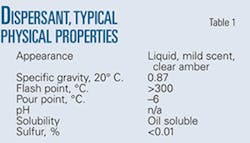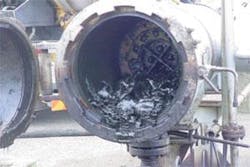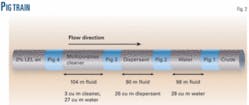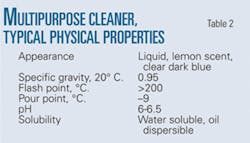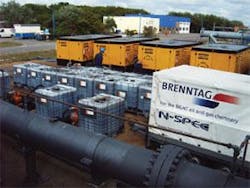Proper chemicals allow safe and economical cleaning and emptying of a large crude line using compressed air, rendering the line hydrocarbon free with a lower explosion level for the air inside the line of 0%.
Brenntag Oil & Gas Europe cleaned a 140-km, 24 in. OD crude transport line for the Total refinery in Vlissingen, Netherlands, using N-SPEC cleaning chemicals. Brenntag applied compressed air as a propelling agent to transport pigs through the pipeline, a technique rarely used in Europe due to the relatively high risks. Brenntag, however, succeeded in removing all hydrocarbons from the pipeline, bringing the LEL down to a unique 0%.
Background
The crude transport line required modification in two places, and some block valves needed to be overhauled to safeguard its operation. Performing these activities necessitated emptying and cleaning the transport line, ensuring the safety of its internal environment to eliminate danger of explosion during welding and cutting.
The maximum allowed LEL was 10% or less, which had to be achieved with the following additional requirements:
- A time frame of about 5 weeks to complete the project.
- Application of compressed air to transport pigs through the pipeline.
- Minimum waste disposal.
- Specific safety precautions set by the client.
Start-up
Prior to performing the cleaning, Brenntag and Visser & Smit Hanab, the pipeline’s main contractor, developed a project execution plan, documenting all elements of the project, and a risk inventory and evaluation, analyzing all possible risks and measures to reduce them to a level acceptable to both Brenntag and VSH.
The plan split the project into three phases:
- Phase 1: online precleaning with several pigging runs.
- Phase 2: removal of the crude and offline cleaning of the pipeline in a single pigging run using Brenntag’s agent, followed by cutting-welding services.
- Phase 3: refilling the line with crude.
Phase 1
The first phase involved precleaning. Lab tests showed a special wax and paraffin dispersant (Table 1), and a multipurpose cleaner (Table 2), would be most effective for this type of contamination and for the total removal of hydrocarbons.
Brenntag carried out the precleaning online to avoid downtime and production losses. Several pig runs removed the first levels of wax and paraffin (Fig. 1). Brenntag monitored all runs, gaining a good indication of the contamination inside the transport line. During the week before the turnaround, Brenntag executed a pig run using 15,000 l. of the dispersant, with the line still in service.
The refinery can process the dispersant as a hydrocarbon without disturbing downstream processes as far as experience shows. All removed wax and paraffin, therefore, including the dispersant, continued into the storage tanks at the refinery, allowing the entire precleaning process to take place with both the pipeline and the refinery remaining online.
Phase 2
The second phase of the project involved removal of the crude and all remaining wax, paraffin, and heavy carbons inside the line, a total of 40,000 cu m. After taking the line out of service and depressurizing it, Brenntag established a pig train, consisting of four designated pigs interspersed with a column of the required chemicals and water (Fig. 2). Compressed air acted as a propelling agent, reducing waste disposal and the time required to complete the project. Also, unlike nitrogen, it has no issues with cold temperatures.
Injecting water in the first compartment, in combination with two designated bidirectional sealing pigs, avoided any contact between air and crude, thereby reducing risk. The pigs also lacked metal parts that could contact the inner pipe wall.
Injecting 26 cu m of the dispersant into the second compartment, removed all remaining wax and paraffin. The third bidirectional pig created agitation in this column of fluid, enhancing the dissolving and dispersal of wax and paraffin.
Injecting 3 cu m of Brenntag’s multipurpose cleaner, diluted by 27 cu m of water, into the third compartment dispersed all heavy carbons. The fourth pig used the same agitation technique as the third to optimize the chemical’s dispersing qualities.
Launching the pigs occurred individually, with the required fluids injected between (Fig. 3). The launch of the first pig took place with water, to avoid any contact between the crude and the compressed air. The first and the fourth pig used transponders, allowing them to be tracked between the Maasvlakte Oil Terminal (Rotterdam) and Vlissingen. The complete pig train launch used five compressors at a pressure of 10 bar and the train traveled at 0.94 m/sec.
The total journey took 41 hr and 25 min, yielding a chemical-deposition contact time calculated to be effective. The water also cleaned all chambers of the block valves, which were thoroughly flushed as the chemicals did their work.
At the Vlissingen receiving site Brenntag created a steel dump line from the receiver to a temporary knockout vessel connected to containers. Equipping the pigs with transponders allowed the velocity of the pig train to be reduced to about 0.5 m/sec near the refinery. The first pig, including the column of water, followed the normal flow direction into Total’s storage tanks during collection. Arrival of the second pig triggered a closing of the normal flow direction, with a temporary dump line opened to collect the rest of the fluids and debris via the knockout vessel into the storage containers. Receipt of the third and fourth pig followed the same pattern.
The conclusion of pig collection required a second line depressurization. A knockout vessel equipped with a 20-in. demister accomplished the bulk of depressurization over 6 hr.
Marsac measured the LEL of the out-flowing air during depressurization at three sites, finding 0% LEL at each of them:
- The launching site at MOT in Rotterdam.
- The receiving site in Vlissingen.
- Block valve station S3.
This safe inside-line environment helped VSH perform required cutting and welding activities within the budgeted time-frame without any spillage or emission to the environment.
Phase 3
Restart of the line following cleaning required refilling it with crude from the MOT in Rotterdam to Total’s refinery in Vlissingen. Two bidirectional separation pigs interspersed by a column of water of about 24 cu m helped accomplish refill, again using the demister. All out-coming air entered the environment without spray. The internal LEL remained 0%.
The author
Peter Verkiel (pverkiel@brenntagoil&gas.com) is European product manager for N-SPEC products and services at Brenntag Oil & Gas Europe, in Dordrecht, the Netherlands. He has also served as pipeline and construction engineer at Shell-NAM and as area manager at A. Hak. He holds a degree in mechanical engineering.
